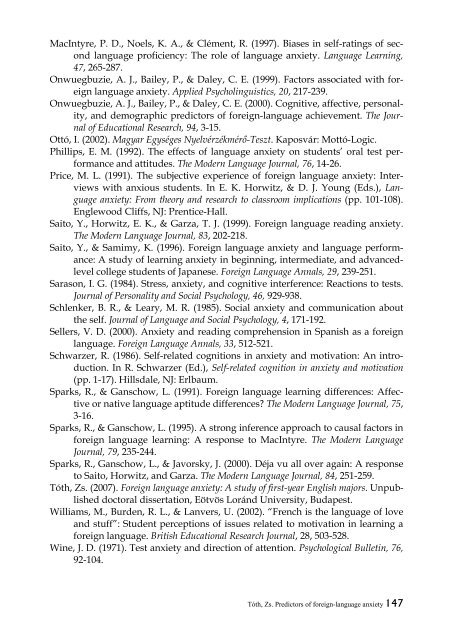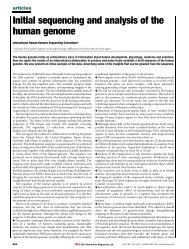Predictors of Foreign-Language Anxiety: Examining the ...
Predictors of Foreign-Language Anxiety: Examining the ...
Predictors of Foreign-Language Anxiety: Examining the ...
Create successful ePaper yourself
Turn your PDF publications into a flip-book with our unique Google optimized e-Paper software.
MacIntyre, P. D., Noels, K. A., & Clément, R. (1997). Biases in self-ratings <strong>of</strong> secondlanguage pr<strong>of</strong>iciency: The role <strong>of</strong> language anxiety. <strong>Language</strong> Learning,47, 265-287.Onwuegbuzie, A. J., Bailey, P., & Daley, C. E. (1999). Factors associated with foreignlanguage anxiety. Applied Psycholinguistics, 20, 217-239.Onwuegbuzie, A. J., Bailey, P., & Daley, C. E. (2000). Cognitive, affective, personality,and demographic predictors <strong>of</strong> foreign-language achievement. The Journal<strong>of</strong> Educational Research, 94, 3-15.Ottó, I. (2002). Magyar Egységes Nyelvérzékmérı-Teszt. Kaposvár: Mottó-Logic.Phillips, E. M. (1992). The effects <strong>of</strong> language anxiety on students’ oral test performanceand attitudes. The Modern <strong>Language</strong> Journal, 76, 14-26.Price, M. L. (1991). The subjective experience <strong>of</strong> foreign language anxiety: Interviewswith anxious students. In E. K. Horwitz, & D. J. Young (Eds.), <strong>Language</strong>anxiety: From <strong>the</strong>ory and research to classroom implications (pp. 101-108).Englewood Cliffs, NJ: Prentice-Hall.Saito, Y., Horwitz, E. K., & Garza, T. J. (1999). <strong>Foreign</strong> language reading anxiety.The Modern <strong>Language</strong> Journal, 83, 202-218.Saito, Y., & Samimy, K. (1996). <strong>Foreign</strong> language anxiety and language performance:A study <strong>of</strong> learning anxiety in beginning, intermediate, and advancedlevelcollege students <strong>of</strong> Japanese. <strong>Foreign</strong> <strong>Language</strong> Annals, 29, 239-251.Sarason, I. G. (1984). Stress, anxiety, and cognitive interference: Reactions to tests.Journal <strong>of</strong> Personality and Social Psychology, 46, 929-938.Schlenker, B. R., & Leary, M. R. (1985). Social anxiety and communication about<strong>the</strong> self. Journal <strong>of</strong> <strong>Language</strong> and Social Psychology, 4, 171-192.Sellers, V. D. (2000). <strong>Anxiety</strong> and reading comprehension in Spanish as a foreignlanguage. <strong>Foreign</strong> <strong>Language</strong> Annals, 33, 512-521.Schwarzer, R. (1986). Self-related cognitions in anxiety and motivation: An introduction.In R. Schwarzer (Ed.), Self-related cognition in anxiety and motivation(pp. 1-17). Hillsdale, NJ: Erlbaum.Sparks, R., & Ganschow, L. (1991). <strong>Foreign</strong> language learning differences: Affectiveor native language aptitude differences? The Modern <strong>Language</strong> Journal, 75,3-16.Sparks, R., & Ganschow, L. (1995). A strong inference approach to causal factors inforeign language learning: A response to MacIntyre. The Modern <strong>Language</strong>Journal, 79, 235-244.Sparks, R., Ganschow, L., & Javorsky, J. (2000). Déja vu all over again: A responseto Saito, Horwitz, and Garza. The Modern <strong>Language</strong> Journal, 84, 251-259.Tóth, Zs. (2007). <strong>Foreign</strong> language anxiety: A study <strong>of</strong> first-year English majors. Unpublisheddoctoral dissertation, Eötvös Loránd University, Budapest.Williams, M., Burden, R. L., & Lanvers, U. (2002). “French is <strong>the</strong> language <strong>of</strong> loveand stuff”: Student perceptions <strong>of</strong> issues related to motivation in learning aforeign language. British Educational Research Journal, 28, 503-528.Wine, J. D. (1971). Test anxiety and direction <strong>of</strong> attention. Psychological Bulletin, 76,92-104.Tóth, Zs. <strong>Predictors</strong> <strong>of</strong> foreign-language anxiety 147
















